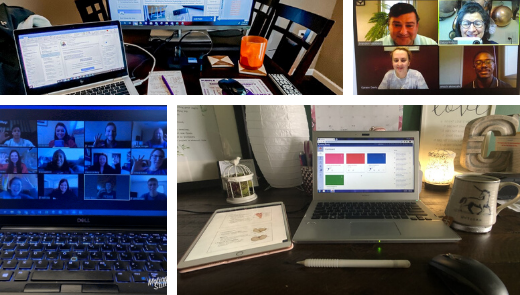Keep Teaching, Keep Learning: K-State demonstrates cyber land-grant university leadership
Monday, March 30, 2020

This collage shows images that Kansas State University students, faculty and staff shared during the first week of remote learning. Through the creation of valuable resources and partnerships, K-State is showing how to keep teaching and keep learning during the transition to remote learning.
MANHATTAN — Kansas State University faculty, students and staff are doing more than showing they can keep teaching and keep learning during the transition to remote learning. They also can rise to the challenge and become worldwide leaders.
To mitigate the spread of COVID-19, all K-State classes transitioned to online and other forms of distance learning beginning March 23. That transition led to the creation of valuable resources and partnerships: Keep Teaching and Keep Learning websites; the Keep Teaching: Resources for Higher Ed online community; and partnerships with rural internet providers.
One impressive achievement: The free online community Keep Teaching: Resources for Higher Ed that K-State Global Campus created has more than 1,500 people involved from across the U.S. and from more than 15 countries. The online community is among the first of its kind in the U.S. and provides a place for higher education peers to share knowledge and resources to support academic continuity.
"Through these new initiatives, K-State has truly established itself as a cyber land-grant university leader," said Charles Taber, K-State provost and executive vice president. "I have been impressed with how quickly and efficiently units across the university have collaborated and created ways to transition to virtual instruction. We have learned so much about what a cyber land-grant university is and will be."
On March 6, Taber established a working group of collaborators to develop a COVID-19 continuity plan. Within 10 days, the group had developed an array of valuable resources for faculty, staff and students.
The efforts have involved more than 30 K-State collaborators from K-State Global Campus, the Office of the Provost, the Teaching and Learning Center, Information Technology Services, K-State Libraries, the Student Access Center, the Office of Institutional Effectiveness, the College of Education and the College of Agriculture.
Keep Teaching initiatives began at universities several years ago in response to disruptive events, such as wildfires or hurricanes, said Katie Linder, executive director for program development with K-State Global Campus. Keep Teaching initiatives help universities maintain academic continuity and the COVID-19 pandemic marked K-State's first Keep Teaching initiative.
K-State's Keep Teaching online community is an innovative approach to a Keep Teaching initiative, Linder said. The online community extends beyond K-State and includes faculty, library staff, information technology professionals and administrators who are from universities around the world and are sharing valuable information on teaching and learning remotely.
Through the online space, K-State is gathering information, organizing it and creating groups. It's a way to share information with people who may feel isolated and to help them make connections across the world, Linder said.
"K-State is truly following the principle of generosity in these challenging times," Linder said. "We're not trying to hoard information and resources. We're opening the conversation and saying, 'We can solve these problems together.' That openness to listening to others and sharing information is a true example of being a leader in the cyber land-grant space."
The university's ability to transition quickly to online learning is the result of another recent disruption: the Hale Library fire. The fire caused significant damage to the university's data center, and K-State took on a Cloud First initiative and quickly moved to a cloud-based system in a few months.
"Because we have moved all of our key applications and services to the cloud, we have experienced very little, if any, slowdowns and no downtime," said Gary Pratt, K-State chief information officer. "With students, staff and faculty accessing these services from home internet connections, and the systems residing in the cloud, very little bandwidth is being accessed using our on-campus connection, which significantly reduces any connectivity issues."
Pratt also has worked with more than 12 internet providers to offer free or discounted services for students and faculty during this time of remote teaching and learning. The providers have signed the Federal Communications Commission's Keep Americans Connected Pledge that was created in response to the COVID-19 pandemic.
K-State's work isn't over. The collaborative team continues to update the Keep Teaching and Keep Learning websites and add new valuable information.
"At K-State, we pride ourselves on providing excellent educational experiences for our students. Our goal was to keep doing that," said Donald Saucier, faculty associate director of the Teaching and Learning Center. "I am proud to contribute to this amazing collective effort. K-State has a lot of superheroes behind the scenes who made this possible."
For information about K-State's online learning initiatives, visit k-state.edu/keepteaching. People also are encouraged to join the Keep Teaching online community.
